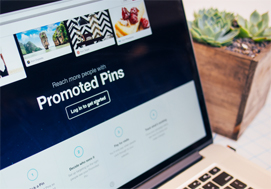Pinterest, Promoted Pins, and self-service social media ads for SMEs
 Running a small business in the digital age isn’t always easy. The inherent problems associated with battling a large rival offline have the unpleasant habit of transferring neatly to the online world.
Running a small business in the digital age isn’t always easy. The inherent problems associated with battling a large rival offline have the unpleasant habit of transferring neatly to the online world.
Websites of firms with big marketing budgets are chocked with content; they command great authority from search engines; their inbound links are often of a high quality; and when search engines make big algorithmic changes, they respond quickly.
For small businesses that can’t compete on organic search, digital platforms offering flexible self-service ads and promotions can be a godsend.
Through its Adwords platform, Google allows creation of specific, targeted ‘pay per click’ (PPC) campaigns that can be tweaked easily through a self-service interface and provide smaller firms the exposure they need.
In fact, one small business owner told Tripp Associates his self-service Adwords had proved so easily manageable – and such a reliable source of revenue – he’d jettisoned his digital consultant and added £2 income to every £1 spent by closely managing campaigns himself.
And where Google has successfully enabled the small business owner, other digital platforms have followed.
Facebook now has more than a million SMEs advertising on its site. It even runs a boot camp to teach small businesses how to advertise on the platform. And as a way of encouraging small businesses to join the rush for promoted tweets and profiles, Twitter helped launch Small Business Week in California earlier this year with an event at its San Francisco headquarters.
To the growing list of social networks keen to align themselves with small businesses, we can now add visual discovery tool Pinterest.
Pinterest’s users collect together ideas for projects using visual bookmarks (‘pins’) and create and share their collections (called ‘boards’) with others. So far more than 30bn pins have been shared on the site, and despite not having a significant revenue stream investors still recently valued the company close to $5bn.
Now, Pinterest is keen to take advantage of its critical mass, to encourage the development of ‘Promoted Pins’, and start to draw revenue.
Firms will soon be able to pay to promote their content in ‘search’ and ‘category’ feeds on the network. Like Adwords and Promoted Tweets, Pin Promotions will be entirely self-service. From a web interface firms will be able to log in, select a pin to promote, then decide what category of user it will be promoted toward. The PPC payment system means businesses only incur a cost when a user clicks their pins. The amount they pay for each click is likely to determine the ad’s ranking and placement.
To provide more intuitive and detailed feedback for its business clients Pinterest has also revamped its analytics dashboards. In addition to letting businesses know content from their own websites is being pinned, the new tools will also enable businesses to see how their pins and boards are performing on the social network, feeding back information on the number of impressions created, how many clicks and ‘repins’ they gain.
The Promoted Pins system was trialled earlier this year with a handful of large advertising clients, including GAP and Kraft. Now, Pinterest is undertaking a second test with small businesses in the US ahead of a full rollout. Reports suggest that Pinterest has been looking to charge $30-$40 per 1,000 clicks on a Promoted Pin.
Unlike mega brands, like Kraft and GAP, small businesses are likely to take a selective approach to social media ads. Lacking the resources to run campaigns across all the major networks will naturally mean more targeted strategies – but when budgets are low, how do businesses know which network will work best for them?
As every network isn’t the same, choosing a network with characteristics in tune with a small business’s aims is vital.
Facebook is great for conversations at scale, promoting offers, and sharing images and videos; Twitter is great for one-on-one conversations, customer service, sharing links to a community, and for posting memorable content. But if your business isn’t interested in those kinds of promotion, what do you do? Where do you go if social networks can’t offer you the platform you need to promote your business the best way?
Those two questions simultaneously mark the problem and the blessing of social media networks. They offer advertisers greater variety than ever before, but as yet still don’t offer quite enough.
With an emphasis on gathering images together, Pinterest’s Promoted Pins will naturally benefit business where designs and collections are major promotional points (fashion retailers? home furnishing outlets?), but perhaps more so, the rollout of this ad service is another step toward a future where increasingly specialised social networks will be able to supply rich and varied ways for advertisers to get their messages to the public.